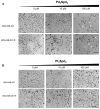Pd(II) and Pt(II) Trinuclear Chelates with Spermidine: Selective Anticancer Activity towards TNBC-Sensitive and -Resistant to Cisplatin
- PMID: 37111690
- PMCID: PMC10145437
- DOI: 10.3390/pharmaceutics15041205
Pd(II) and Pt(II) Trinuclear Chelates with Spermidine: Selective Anticancer Activity towards TNBC-Sensitive and -Resistant to Cisplatin
Abstract
Triple-negative breast cancer (TNBC) is one of the most aggressive forms of breast cancer and constitutes 10-20% of all breast cancer cases. Even though platinum-based drugs such as cisplatin and carboplatin are effective in TNBC patients, their toxicity and development of cancer drug resistance often hamper their clinical use. Hence, novel drug entities with improved tolerability and selectivity profiles, as well as the ability to surpass resistance, are needed. The current study focuses on Pd(II) and Pt(II) trinuclear chelates with spermidine (Pd3Spd2 and Pt3Spd2) for evaluating their antineoplastic activity having been assessed towards (i) cisplatin-resistant TNBC cells (MDA-MB-231/R), (ii) cisplatin-sensitive TNBC cells (MDA-MB-231) and (iii) non-cancerous human breast cells (MCF-12A, to assess the cancer selectivity/selectivity index). Additionally, the complexes' ability to overcome acquired resistance (resistance index) was determined. This study revealed that Pd3Spd2 activity greatly exceeds that displayed by its Pt analog. In addition, Pd3Spd2 evidenced a similar antiproliferative activity in both sensitive and resistant TNBC cells (IC50 values 4.65-8.99 µM and 9.24-13.34 µM, respectively), with a resistance index lower than 2.3. Moreover, this Pd compound showed a promising selectivity index ratio: >6.28 for MDA-MB-231 cells and >4.59 for MDA-MB-231/R cells. Altogether, the data presently gathered reveal Pd3Spd2 as a new, promising metal-based anticancer agent, which should be further explored for the treatment of TNBC and its cisplatin-resistant forms.
Keywords: antineoplastic activity; antiproliferative; cancer resistance; cell viability; cisplatin; palladium; platinum; therapy.
Conflict of interest statement
The authors declare no conflict of interest.
Figures






References
-
- Diana A., Franzese E., Centonze S., Carlino F., Della Corte C.M., Ventriglia J., Petrillo A., De Vita F., Alfano R., Ciardiello F., et al. Triple-Negative Breast Cancers: Systematic Review of the Literature on Molecular and Clinical Features with a Focus on Treatment with Innovative Drugs. Curr. Oncol. Rep. 2018;20:76. doi: 10.1007/s11912-018-0726-6. - DOI - PubMed
Grants and funding
LinkOut - more resources
Full Text Sources
Miscellaneous

